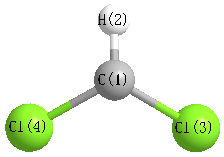Jump to
S1C2
Energy calculated at MP3=FULL/aug-cc-pVDZ
| | hartrees |
|---|
| Energy at 0K | -957.868082 |
| Energy at 298.15K | |
| HF Energy | -957.409113 |
| Nuclear repulsion energy | 124.898935 |
The energy at 298.15K was derived from the energy at 0K
and an integrated heat capacity that used the calculated vibrational frequencies.
Vibrational Frequencies calculated at MP3=FULL/aug-cc-pVDZ
| Mode Number |
Symmetry |
Frequency
(cm-1) |
Scaled Frequency
(cm-1) |
IR Intensities
(km mol-1) |
Raman Act
(Å4/u) |
Dep P |
Dep U |
|---|
| 1 |
A1 |
3328 |
3328 |
0.90 |
|
|
|
| 2 |
A1 |
759 |
759 |
7.90 |
|
|
|
| 3 |
A1 |
312 |
312 |
0.46 |
|
|
|
| 4 |
B1 |
471i |
471i |
34.72 |
|
|
|
| 5 |
B2 |
1245 |
1245 |
60.66 |
|
|
|
| 6 |
B2 |
945 |
945 |
126.94 |
|
|
|
Unscaled Zero Point Vibrational Energy (zpe) 3058.7 cm
-1
Scaled (by 1) Zero Point Vibrational Energy (zpe) 3058.7 cm
-1
See section
III.C.1 List or set vibrational scaling factors
to change the scale factors used here.
See section
III.C.2
Calculate a vibrational scaling factor for a given set of molecules
to determine the least squares best scaling factor.
Geometric Data calculated at MP3=FULL/aug-cc-pVDZ
Point Group is C2v
Cartesians (Å)
| Atom |
x (Å) |
y (Å) |
z (Å) |
|---|
| C1 |
0.000 |
0.000 |
0.681 |
| H2 |
0.000 |
0.000 |
1.765 |
| Cl3 |
0.000 |
1.484 |
-0.172 |
| Cl4 |
0.000 |
-1.484 |
-0.172 |
Atom - Atom Distances (Å)
| |
C1 |
H2 |
Cl3 |
Cl4 |
| C1 | | 1.0839 | 1.7118 | 1.7118 |
H2 | 1.0839 | | 2.4404 | 2.4404 | Cl3 | 1.7118 | 2.4404 | | 2.9676 | Cl4 | 1.7118 | 2.4404 | 2.9676 | |
 More geometry information
More geometry information
Calculated Bond Angles
| atom1 |
atom2 |
atom3 |
angle |
|
atom1 |
atom2 |
atom3 |
angle |
| Cl3 |
C1 |
H2 |
119.910 |
|
Cl3 |
C1 |
Cl4 |
120.179 |
| Cl4 |
C1 |
H2 |
119.910 |
|
Electronic energy levels
Charges, Dipole, Quadrupole and Polarizability
Jump to
S1C1
Energy calculated at MP3=FULL/aug-cc-pVDZ
| | hartrees |
|---|
| Energy at 0K | -957.869828 |
| Energy at 298.15K | -957.870700 |
| HF Energy | -957.411280 |
| Nuclear repulsion energy | 124.666139 |
The energy at 298.15K was derived from the energy at 0K
and an integrated heat capacity that used the calculated vibrational frequencies.
Vibrational Frequencies calculated at MP3=FULL/aug-cc-pVDZ
| Mode Number |
Symmetry |
Frequency
(cm-1) |
Scaled Frequency
(cm-1) |
IR Intensities
(km mol-1) |
Raman Act
(Å4/u) |
Dep P |
Dep U |
|---|
| 1 |
A' |
3263 |
3263 |
0.93 |
|
|
|
| 2 |
A' |
770 |
770 |
15.08 |
|
|
|
| 3 |
A' |
579 |
579 |
13.81 |
|
|
|
| 4 |
A' |
305 |
305 |
0.34 |
|
|
|
| 5 |
A" |
1245 |
1245 |
45.05 |
|
|
|
| 6 |
A" |
901 |
901 |
157.12 |
|
|
|
Unscaled Zero Point Vibrational Energy (zpe) 3531.2 cm
-1
Scaled (by 1) Zero Point Vibrational Energy (zpe) 3531.2 cm
-1
See section
III.C.1 List or set vibrational scaling factors
to change the scale factors used here.
See section
III.C.2
Calculate a vibrational scaling factor for a given set of molecules
to determine the least squares best scaling factor.
Geometric Data calculated at MP3=FULL/aug-cc-pVDZ
Point Group is Cs
Cartesians (Å)
| Atom |
x (Å) |
y (Å) |
z (Å) |
|---|
| C1 |
0.014 |
0.714 |
0.000 |
| H2 |
-0.557 |
1.641 |
0.000 |
| Cl3 |
0.014 |
-0.174 |
1.479 |
| Cl4 |
0.014 |
-0.174 |
-1.479 |
Atom - Atom Distances (Å)
| |
C1 |
H2 |
Cl3 |
Cl4 |
| C1 | | 1.0892 | 1.7250 | 1.7250 |
H2 | 1.0892 | | 2.4102 | 2.4102 | Cl3 | 1.7250 | 2.4102 | | 2.9578 | Cl4 | 1.7250 | 2.4102 | 2.9578 | |
 More geometry information
More geometry information
Calculated Bond Angles
| atom1 |
atom2 |
atom3 |
angle |
|
atom1 |
atom2 |
atom3 |
angle |
| Cl3 |
C1 |
H2 |
115.993 |
|
Cl3 |
C1 |
Cl4 |
118.036 |
| Cl4 |
C1 |
H2 |
115.993 |
|
Electronic energy levels
Charges, Dipole, Quadrupole and Polarizability
